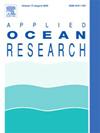Evacuation simulation in inclined ship environment based on improved social force model
IF 4.3
2区 工程技术
Q1 ENGINEERING, OCEAN
引用次数: 0
Abstract
To evaluate the evacuation capability of pedestrians in an inclined ship environment, this paper establishes an evacuation model that incorporates both the pushing and self-adjustment forces of pedestrians, based on the social force model. The entropy method is applied to determine the coefficient of pedestrian speed attenuation. Considering the presence of panic during evacuation, a pushing effect model is developed. In this model, a Sigmoid function is used to describe the influence of the inclination angle on the intensity of the pushing effects. Pedestrian spacing and movement direction are introduced as criteria for determining the occurrence of pushing effects. A dynamic assessment of the pushing effect during evacuation is conducted, effectively simulating a realistic evacuation process in an inclined ship environment. Through simulation of a single cabin, the pushing effect among pedestrians during the evacuation process was reproduced, and the presence of pushing increased the evacuation time. Compared to related literature, the evacuation time trend in this study is generally similar; however, considering the presence of pushing effects, the evacuation time obtained in this study is relatively longer. Compared to Pathfinder, the model developed in this study can simulate the pushing effect between pedestrians and accurately reflect the behavior dynamics of crowds under ship inclination conditions.
求助全文
约1分钟内获得全文
求助全文
来源期刊

Applied Ocean Research
地学-工程:大洋
CiteScore
8.70
自引率
7.00%
发文量
316
审稿时长
59 days
期刊介绍:
The aim of Applied Ocean Research is to encourage the submission of papers that advance the state of knowledge in a range of topics relevant to ocean engineering.
 求助内容:
求助内容: 应助结果提醒方式:
应助结果提醒方式:


